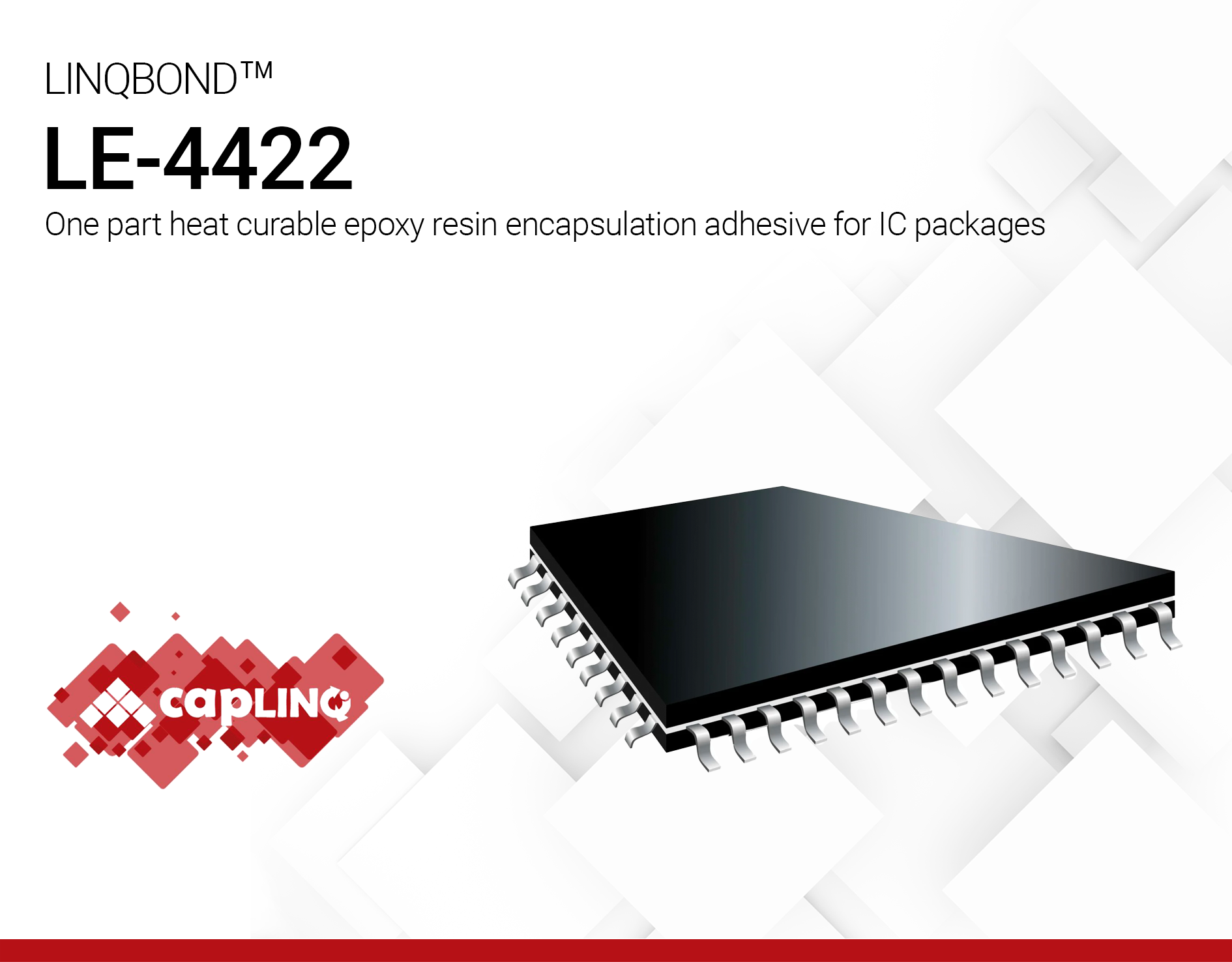LINQBOND LE-4422 | one part epoxy resin
- Good thermal resistance
- Quick and efficient curing
- Outstanding electrical properties
Product Description
LINQBOND LE-4422 is a one-part epoxy resin specifically developed for IC packaging. It is used in a wide range of electronic devices, including but not limited electronic watches, calculators, game consoles, and e-readers.
LINQBOND LE-4422 cures quickly and efficiently at high temperatures. Medium height (approximately 2.0 mm) can be achieved after curing. It has outstanding electrical properties, high peel strength, and excellent thermal resistance. It exhibits good adhesion strength to circuit boards, making it ideal for IC applications and providing excellent protection for aluminum wires.
Technical Specifications
| General Properties | |||||||
| |||||||
| Specific Gravity Specific Gravity Specific gravity (SG) is the ratio of the density of a substance to the density of a reference substance; equivalently, it is the ratio of the mass of a substance to the mass of a reference substance for the same given volume. For liquids, the reference substance is almost always water (1), while for gases, it is air (1.18) at room temperature. Specific gravity is unitless. | 1.4–1.5 | ||||||
| Physical Properties | |||||||
| Viscosity Viscosity Viscosity is a measurement of a fluid’s resistance to flow. Viscosity is commonly measured in centiPoise (cP). One cP is defined as the viscosity of water and all other viscosities are derived from this base. MPa is another common unit with a 1:1 conversion to cP. A product like honey would have a much higher viscosity -around 10,000 cPs- compared to water. As a result, honey would flow much slower out of a tipped glass than water would. The viscosity of a material can be decreased with an increase in temperature in order to better suit an application | 35,000–60,000 mPa.s | ||||||
| Young's modulus | 3974 MPa | ||||||
| Chemical Properties | |||||||
| Water Absorption | 0.3 % | ||||||
| Mechanical Properties | |||||||
| |||||||
| Electrical Properties | |||||||
| Volume Resistivity Volume Resistivity Volume resistivity, also called volume resistance, bulk resistance or bulk resistivity is a thickness dependent measurement of the resistivity of a material perpendicular to the plane of the surface. | >1.0 (E15) Ohms⋅cm | ||||||
| Thermal Properties | |||||||
| |||||||
| |||||||
| Glass Transition Temperature (Tg) Glass Transition Temperature (Tg) The glass transition temperature for organic adhesives is a temperature region where the polymers change from glassy and brittle to soft and rubbery. Increasing the temperature further continues the softening process as the viscosity drops too. Temperatures between the glass transition temperature and below the decomposition point of the adhesive are the best region for bonding. The glass-transition temperature Tg of a material characterizes the range of temperatures over which this glass transition occurs. | 142 °C | ||||||
Additional Information
What’s the recommended dispensing process to avoid the voids?
- LE-4422 should be applied in a controlled and consistent manner. Abrupt pouring should be avoided. It is recommended to use dispensing equipment to control material flow and allow air to escape as the material fills the package.
- Recommended dispensing machine: Peristatic Dispensing Pump.
- Mold design is also a factor along with the dispense pattern being used and the dispense volume consistency.
Precautions for use
- This product needs to be stored at low temperatures and at dry places. The shelf life will vary depending on the storage conditions.
- When the material is take out from refrigeration, thaw it first prior to use. Keep in an airtight container at room temperature. After thawing for at least 6 to 8 hours, open and then use.
- Maintain a clean and ventilated workplace, using extraction trunks when necessary.
- Wear appropriate protective equipment and minimize direct contact with the human body. Refer to the Material Safety Data Sheet (SDS) before use.
Please note that the provided information is based on available data and typical conditions. For specific applications and detailed test results, refer to the actual test data and conduct appropriate certifications.
Storage and Handling
Store in a ventilated, dry, and clean environment below 25 °C. Keep away from fire and heat sources. It is strictly forbidden to store in outdoor environments. Shelf life can be extended by using cold storage.
What would be the effect on the product's performance after the guaranteed shelf-life? (for Failure Analysis).
Effects of using 1-part epoxy after guaranteed shelf-life:
- Changes in viscosity & flowability due to premature crosslinking
- Decrease in bonding performance
For optimal results, adhering to the recommended shelf-life and proper storage conditions is essential.



